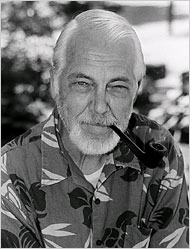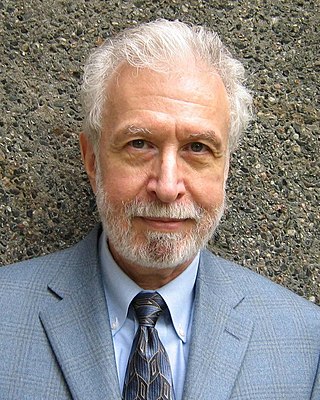James H. Geer is an American psychologist. His area of research is sexuality.
James H. Geer is an American psychologist. His area of research is sexuality.
Geer has researched sexuality for over 30 years. He explores the psychophysiology of sexual arousal and cognitive variables in sexuality. He worked on the faculty at University at Buffalo, University of Pennsylvania, and Stony Brook University. He retired from his position at Louisiana State University and moved to the Lancaster area to work as a visiting scholar at Franklin & Marshall College. [1]

A paraphilia is an experience of recurring or intense sexual arousal to atypical objects, places, situations, fantasies, behaviors, or individuals. It has also been defined as a sexual interest in anything other than a legally consenting human partner. Paraphilias are contrasted with normophilic ("normal") sexual interests, though the definition of what makes a sexual interest normal or atypical remains controversial.

Sexology is the scientific study of human sexuality, including human sexual interests, behaviors, and functions. The term sexology does not generally refer to the non-scientific study of sexuality, such as social criticism.
Queer theory is a field of post-structuralist critical theory that emerged in the early 1990s out of queer studies and women's studies.

Sexual fetishism or erotic fetishism is a sexual fixation on a nonliving object or body part. The object of interest is called the fetish; the person who has a fetish for that object is a fetishist. A sexual fetish may be regarded as a mental disorder if it causes significant psychosocial distress for the person or has detrimental effects on important areas of their life. Sexual arousal from a particular body part can be further classified as partialism.
Frotteurism is a paraphilic interest in rubbing, usually one's pelvic area or erect penis, against a non-consenting person for sexual pleasure. It may involve touching any part of the body, including the genital area. A person who practices frotteuristic acts is known as a frotteur.
The Masters and Johnson research team, composed of William H. Masters and Virginia E. Johnson, pioneered research into the nature of human sexual response and the diagnosis and treatment of sexual disorders and dysfunctions from 1957 until the 1990s.
Vaginal photoplethysmography is a technique using light to measure the amount of blood in the walls of the vagina. The device that is used is called a vaginal photometer.
Somnophilia is a paraphilia in which an individual becomes sexually aroused by someone who is unconscious. The Dictionary of Psychology categorized somnophilia within the classification of predatory paraphilias.
Abasiophilia is a psychosexual attraction to people with impaired mobility, especially those who use orthopaedic appliances such as leg braces, orthopedic casts, or wheelchairs. The term abasiophilia was first used by John Money of the Johns Hopkins University in a paper on paraphilias, in 1990.
Isidor Isaak Sadger, born in Neu Sandez, Galicia, was a forensic medical doctor and psychoanalyst in Vienna. A leader in the early development of psychoanalysis, he began his career as a neurological specialist and, in 1894, began publishing a series of articles on psychophysiology. He studied with Sigmund Freud from 1895 to 1904 with a concentration in homosexuality and fetishism and coined the term Sadomasochismus (sadomasochism) in 1913. He also coined the term "Narcissmus" (narcissism). In September 1942, he was deported to the Theresienstadt concentration camp, where he died.

David Thoreson Lykken was a behavioral geneticist and Professor Emeritus of Psychology and Psychiatry at the University of Minnesota. He is best known for his work on twin studies and lie detection.

Androphilia and gynephilia are terms used in behavioral science to describe sexual orientation, as an alternative to a gender binary homosexual and heterosexual conceptualization. Androphilia describes sexual attraction to men and/or masculinity; gynephilia describes the sexual attraction to women and/or femininity. Ambiphilia describes the combination of both androphilia and gynephilia in a given individual, or bisexuality.

Ray Milton Blanchard III is an American-Canadian sexologist who researches pedophilia, sexual orientation and gender identity. He has found that men with more older brothers are more likely to be gay than men with fewer older brothers, a phenomenon he attributes to the reaction of the mother's immune system to male fetuses. Blanchard has also published research studies on phallometry and several paraphilias, including autoerotic asphyxia. Blanchard also proposed a typology of transsexualism.
John H. Gagnon was a pioneering sociologist of human sexuality who wrote and edited 15 books and over 100 articles. He collaborated with William Simon to develop the piece he is perhaps best recognized for: "Sexual Conduct: The Social Sources of Human Sexuality" (1973). He was Distinguished Emeritus Professor of Sociology at the State University of New York at Stony Brook, where he taught and from 1968 to 1998. In that same time frame, he also dedicated himself to advancing the field of sociology through his research.

Partialism is a sexual fetish with an exclusive focus on a specific part of the body other than genitals. Partialism is categorized as a fetishistic disorder in the DSM-5 of the American Psychiatric Association only if it causes significant psychosocial distress for the person or has detrimental effects on important areas of their life. In the DSM-IV, it was considered a separate paraphilia, but was merged into fetishistic disorder by the DSM-5. Individuals who exhibit partialism sometimes describe the anatomy of interest to them as having equal or greater erotic attraction for them as do the genitals.
Zoophilia is a paraphilia in which a person experiences a sexual fixation on non-human animals. Bestiality instead refers to cross-species sexual activity between humans and non-human animals. Due to the lack of research on the subject, it is difficult to conclude how prevalent bestiality is. Zoophilia, however, was estimated in one study to be prevalent in 2% of the population in 2021.
Penis envy is a stage in Sigmund Freud's theory of female psychosexual development, in which young girls experience anxiety upon realization that they do not have a penis. Freud considered this realization a defining moment in a series of transitions toward a mature female sexuality. In Freudian theory, the penis envy stage begins the transition from attachment to the mother to competition with the mother for the attention and affection of the father. The young boy's realization that women do not have a penis is thought to result in castration anxiety.

Ira Leonard Reiss was an American sociologist with primary interests in studying the way society impacts sexual attitudes and behaviors and how people respond to those pressures. He also had interests in the study of gender and family, particularly as they relate to sexuality. He attended Syracuse University for his B.S. degree and the Pennsylvania State University for his M. A. and Ph. D. degrees. His major area in graduate school was sociology and his minor areas were cultural anthropology and philosophy. His doctoral course work in sociology and philosophy was done at Columbia University and his French and German language study was taken at Yale University.
William T. "Bill" O'Donohue is an American psychologist who focuses on human sexuality, especially child sexual abuse. In 2009 O'Donohue was appointed as advisor to the DSM-V Work Group on Sexual and Gender Identity Disorders of the American Psychiatric Association.

"The Myth of the Vaginal Orgasm" is a feminist essay on women's sexuality written by American radical feminist activist Anne Koedt in 1968, and published in 1970. It first appeared in a four-paragraph outline form in the Notes from the First Year which resulted in an extended article in Notes from the Second Year journals published by the New York Radical Women and was partially based on findings from Masters and Johnson's 1966 work Human Sexual Response. It was then distributed as a pamphlet in its full form, including sections on evidence for the clitoral orgasm, female anatomy, and reasons the "myth" of vaginal orgasm is maintained.